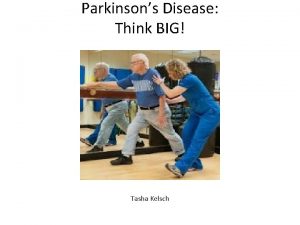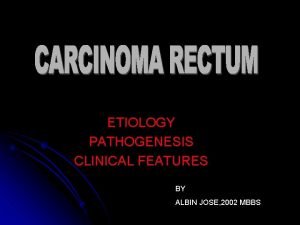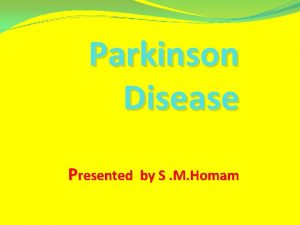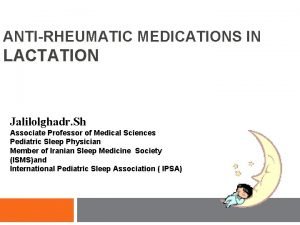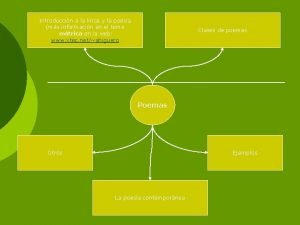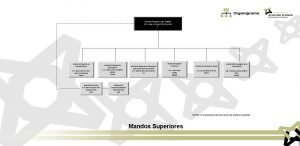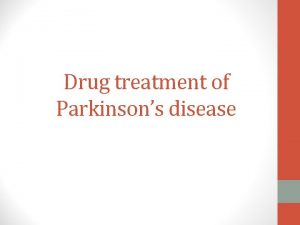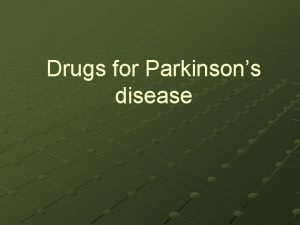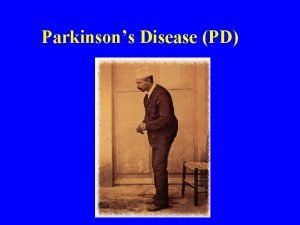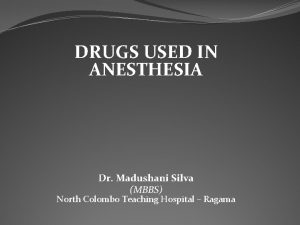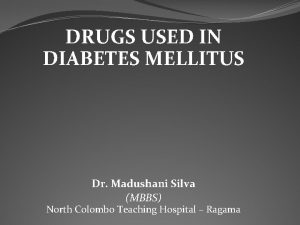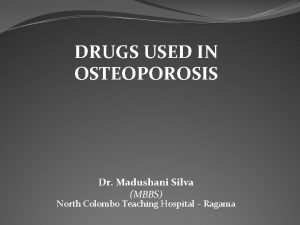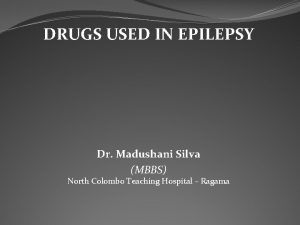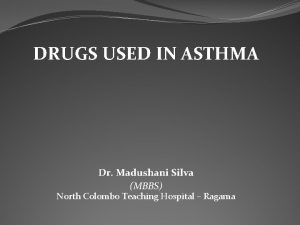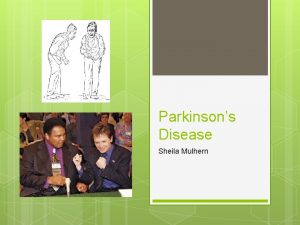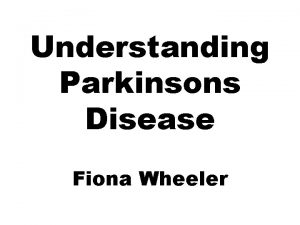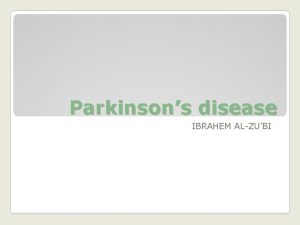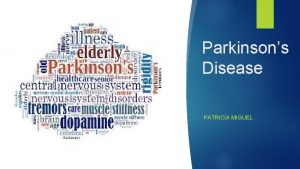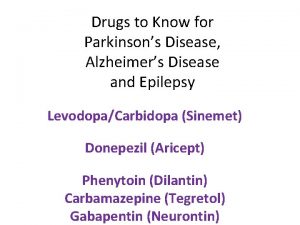DRUGS USED IN PARKINSONS DISEASE Dr Madushani Silva































- Slides: 31

DRUGS USED IN PARKINSON’S DISEASE Dr. Madushani Silva (MBBS) North Colombo Teaching Hospital – Ragama

What is Parkinson’s disease �Parkinson's disease (PD) is a degenerative disorder of the central nervous system with motor system disorders, which are the result of the loss of dopamine -producing brain cells �Usually affects people over the age of 50

Idiopathic Parkinson’s disease �Pathology �Progressive degeneration of cells within the substantia nigra �Loss of dopaminergic cells in the substantia nigra causes a reduction in dopamine in the striatum �Degeneration also occurs in the other basal ganglia nuclei


Aetiology �Cause is unknown

Clinical features �Classical triad of tremor, rigidity & bradykinesia, in association with changes in posture & gait �An important characteristic feature of Parkinson’s disease is the striking asymmetry of the clinical signs �initially more prominent on one side �Symptoms develops slowly, over months or several years �Most common initial symptoms are tremor & slowness

�Tremor �Characteristic coarse resting tremor usually decreased with action of tremulous limb & increased with emotion & distraction (walking or using the contralateral limbs) �Tremor disappears during sleep �Often “pill-rolling nature” - thumb moves rhythmically backwards & forwards on the palmar surface of the fingers �Resting tremor can affect the any part of the body including chin, tongue & feet

�Rigidity �Lead pipe rigidity – stiffness of the limbs, which can be felt throughout the range of movement & equally in the flexors & the extensors �When stiffness occurs with the tremor, smooth ‘lead pipe’ rigidity is broken up in to a jerky resistance to passive movement known as cogwheeling or cogging �Rigidity is usually asymmetrical in the limbs

�Bradykinesia (akinesia, hypokinesia) �Slowing & poverty of movement is the most disabling feature of the Parkinson’s disease �There is difficulty in initiating & terminating the movements �Rapid fine finger movements (piano-playing) become indistinct �Bradykinesia & hypokinesia also affects to muscles of facial expression, so facial immobility gives masklike semblance of depression (hypomimia) �Frequency of spontaneous blinking is reduced

�Postural changes �Posture is characteristically shuffling, forward flexed, festinant gait (hurrying) & poor asymmetrical arm swing �Falls are common later in the disease �When pt tries to turn either when walking or lying (in bed), there are greater difficulty �Speech is altered, initially monotonus but progress to tremulous slurring dysarthria due to a combination of bradykinesia, rigidity & tremor

�Other features �Handwriting reduces in size & become spidery (micrographia) �Sensory is normal �Anxiety & depression are common �Cognitive function is preserved in the early stages but dementia occur at later. �Heartburn, dysphagia, constipation & weight loss �Urinary difficulties are common �Reflexes are active and energitic. �Skin is greasy & sweating excessive



Micrographia The main problem in this disease is Mask-like expressionless face Flexed posture Pill-rolling tremor of the hand Stiff, shuffling posture

Main categories �Dopaminergic drugs used in parkinsonism �Antimuscarinic drugs used in parkinsonism

Principles of Drug Treatment �Each patient with PD may present with a different pattern of the disease. Therefore the management should be individually decided. �Drug treatment should be started only when it is decided necessary in each individual case. �Parkinson’s Disease is relatively easily controlled in the first few years.

Principles of Drug Treatment �About 50% of patients experience significant complications of treatment after 5 years. �the gain of controlling symptoms should be compared with the adverse effects of long-term drug treatment. �The mainstay of antiparkinsonian therapy is restoring Dopaminergic /Cholinergic balance.

�Dopaminergic /Cholinergic balance is achieved by: Ø Enhancing dopaminergic activity by drugs that: v replace neuronal Dopamine: Levodopa v act as Dopamine agonists: Bromocriptine v prolong the action of Dopamine by selective inhibition of its metabolism: MOA-B Inhibitor- Selegiline v release Dopamine from stores and inhibit re-uptake: Amantadine

ØReduction of Cholinergic activity by anticholinergic drugs: drugs acting as antagonists on the muscarinic cholinergic receptors (antimuscarinic drugs): Benzhexol �

Drugs Enhancing Dopaminergic Activity Dopamine replacement: Levodopa (Levodopa+peripheral dopadecraboxylase inhibitor) �Levodopa+benserazide: Co-beneldopa e. g. Co-beneldopa 25/100 – benserazide 25 mg + Levodopa 100 mg �Levodopa+carbidopa: Co-careldopa e. g. Co-careldopa 12. 5/50 – carbidopa 12. 5 + Levodopa 50 mg § Why this combination? * make more levodopa available to cross the BBB: *prevent peripheral side effects by preventing Dopamine formation peripherally: nausea, vomiting, CVS effects.

§ LEVO-DOPA, DOPA= dihydroxyphenylalanine (natural amino acid precursor of dopamine. § Dopamine is not given as it is: o rapidly metabolized in the gut, liver and blood by monoamine oxidase (MAO) and catechol-Omethyltransferase (COMT). o Not lipid soluble enough to cross the BBB § Levodopa is well absorbed in the upper small intestine by active amino acid transport. § Levodopa reaches the CNS by crossing the BBB by a similar active amino acid transport mechanism.

§ less valuable in post - encephalitic parkinsonism, elderly patients and in long standing disease. § Provides biggest improvement in motor symptoms, when compared to other drugs. § Associated with development of dyskinesias after 5 -10 years of its use, sometimes earlier than this. § Abrupt discontinuation of therapy result in relapse.

§ Adverse effects: �Levodopa-induced dyskinesia: involuntary limb jerking, head, lip or tongue movements. Mental changes: depression, dreams, hallucinations, delusions

Increasing Dopaminergic Activity Dopamine agonists Supress prolactin release: inhibit effect on the anterior pituitary. § § § Bromocriptine Pergolide Lisuride Cabergoline Ropinirole Pramipexole

�Less likely to cause dyskinesias, but have less powerful motor effects when compared with levodopa, only about 30% of patients show improvement in motor symptoms. Drugs prolonging the action of Dopamine by selective inhibition of its metabolism Monoamine oxidase -B-inhibitors § Selegiline �Used in early mild cases to delay the use of levodopa or dopamine agonists. Catechol-O-Methyl Transferase Inhibitors (COMTI) § Entacapone �Helps to relieve end of dose deterioration without causing dyskinesia.

Drugs releasing Dopamine: § Amantadine �Is an antiviral drug. �Increase synthesis and release of dopamine. �Inhibit neuronal re-uptake of dopamine. �Has slight antimuscarinic effects. �More effective than antimuscarinic drugs. �Relatively free of side effects. � .

Antimuscarinic Drugs §Benzatropine §Benzhexol (trihexiphenidyl) §Orphenadrine §Procyclidine • Block Ach receptors in the CNS. • no significant action on bradykinesia. • Useful in drug-induced parkinsonism. • Benztropine & Procyclidine available as injections: Rx for acute dystonic reaction. • Side effects: anticholinergic effects.

�Levodopa - release brain dopamine from nerve endings making it more available to activate dopaminergic receptors, Bromocriptine – dopamine receptor agonist

�Antimuscarinic drugs exert their antiparkinsonian action by reducing the effects of the central cholinergic excess that occur as a result of dopamine deficiency

Questions ?

THANK YOU
 Basal ganglia
Basal ganglia Parkinsons disease
Parkinsons disease Shy drager syndrome
Shy drager syndrome Is parkinsons hereditery
Is parkinsons hereditery Amantadin
Amantadin Behcets disease wiki
Behcets disease wiki Disease modifying antirheumatic drugs
Disease modifying antirheumatic drugs Communicable disease and non communicable disease
Communicable disease and non communicable disease 7 tray in labour room
7 tray in labour room Drugs used in pregnancy
Drugs used in pregnancy Wgep
Wgep Catalina cantarina catalina encantadora
Catalina cantarina catalina encantadora Diogo silva taekwondo
Diogo silva taekwondo Greta silva
Greta silva Alexandre kieslich da silva
Alexandre kieslich da silva Tomaz tadeu da silva
Tomaz tadeu da silva Paula melo silva
Paula melo silva Ricardo luiz menezes da silva
Ricardo luiz menezes da silva Mussman architects
Mussman architects Iolanda barbosa da silva
Iolanda barbosa da silva Ejemplos romance
Ejemplos romance Ronald granz
Ronald granz Rosana louro ferreira silva
Rosana louro ferreira silva Marcos regis da silva
Marcos regis da silva João leite da silva ortiz
João leite da silva ortiz Francisco javier salazar silva
Francisco javier salazar silva Fisiquisilva
Fisiquisilva Anushka de silva
Anushka de silva Paula melo silva
Paula melo silva Maria stela campos da silva
Maria stela campos da silva Lucielene maria silva de luiz
Lucielene maria silva de luiz Nelson lucas silva alencastro
Nelson lucas silva alencastro

